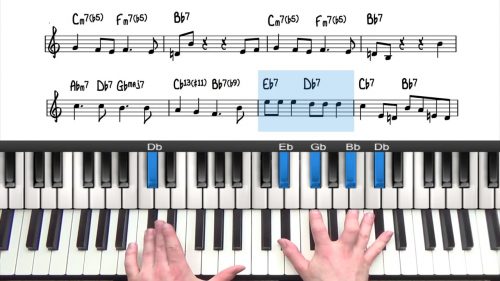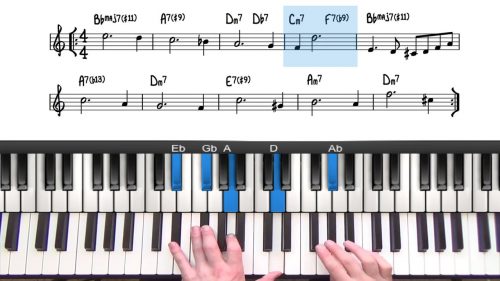Sus Chords For Jazz Piano
In this lesson we are going to look at Sus chords. We have used Sus voicings in many of the jazz standard tutorials and I’ve received some requests to do a dedicated lesson on this type of chord.
‘Sus’ is shorthand for ‘suspended’ and it refers to the 4th which is said to be ‘suspended’ in the chord. Generally speaking, a Sus chord can be defined as a dominant chord where the major third is replaced by the perfect fourth a half step higher. However, you can also voice a Sus chord with both the major 3rd and the suspended 4th.
We start the lesson by recapping the basic theory behind Sus chords and then look at them in context of major and minor 251 progressions. Throughout the lesson we will be applying these voicings to examples in jazz standards so that you understand the application in a practical context.
Lesson Downloads
-
Sus Chords Lesson Supplement File Type: pdf
Practice Tips
-
The first step is to understand the basic construction of the sus chord.
-
The easiest way to build a sus voicing is to play the root in the left hand, and a major triad off the b7 to create a Sus9 voicing.
-
Play a major 7th chord off the b7 to create a sus13 voicing
-
Next apply these voicings to the major 251 progression. Practice including the suspension over the V chord and then resolve the suspension by dropping the 4th to the 3rd.
-
Once you are comfortable with this, try adding an alteration when you resolve the suspension.
-
You can choose from any of the altered tones. Remember you can also play an upper structure triad after the suspension before resolving to the I chord.
-
Finally, perhaps the most important step... is to apply your knowledge to the jazz standards you are playing.
- You can add the additional sus movement to any 251 progression, but some will sound better than others... this is a process of discovery.








Hi Hayden. I just want to make sure I understood this. At 19:23 you played a tritone substituion off G7 which was an upper structure off Db’s sharp nine which is e major. Is that correct?
Hi Josh,
Yes that’s correct.
The V chord is G7, and we first played G13sus4 which is a suspension over the G7.
We could have then simply dropped the C by half a step to B, and we would be playing G13. The sus4 (C) resolves down to the major 3rd (B).
However, instead of going to G13, we went from G13sus4 to the tritone of G7 which is Db7.
As you point out, we also played an upper structure triad to create Db13#11 (major triad off 9) … there is no sharp 9 in the chord.. the upper structure contains the natural 9, #11 and 13.
Think of the Db13#11 as a passing chord, in between G7 and Cmaj7.
Does this help?
Cheers,
Hayden
Hi Hayden, at 10:00 why are the G7 chords on the right and left called G7 chords and not G13 as they have the 9th and 13th in the chord? I have seen this elsewhere too with dominant chords where there are extensions but it is still called a 7th.
Hi Brian, yes this is an important thing to understand….
Jazz musicians often abbreviate chords to just ‘7’, eg. G-7 or C7 – even if the chord contains higher extensions such as 9s, 11s or 13s.
Look at this as ‘shorthand’.
If you’re playing with other jazz musicians, and you asked them what chord they are playing, as an example, they may say Cmaj7, when in fact they are playing Cmaj13#11. The essential information is the chord root (C) and the basic chord quality (maj7) which is conveyed by saying “Cmaj7”
This also applied to lead sheets…. just because the chord symbol says ‘7’ … you have the creative freedom to add in extensions and alterations. That is the beauty of playing jazz music… you have a lot of freedom to interpret the chords how you want to.
I use “7” in my lessons to train students to see the chord symbol, register the chord quality (major, minor, -7b5, dominant), and then make their own decision on what to include or exclude in terms of extensions and alterations. This is how you will come across chords on a lead sheet, and so it made sense to mimic this in my lessons.
That, in essence, is playing jazz music. You could completely reharmonise the chord if you want to… anything goes! :-)
If you pick up a lead sheet and restrict yourself to the exact extensions and alterations written, then it becomes less of your own interpretation of the song, you are just playing what’s written. This is what makes someones arrangement sound unique to them, because they have thought “what if I added this in”, or “what if we made that a sus chord” etc…
The same goes for the melody, if you play the melody exactly as it’s written on the lead sheet, chances are it might sound quite plain…. the best thing to do is listen to many recordings of the tune, emulate their phrasing, additional notes, perhaps notes they have takes out etc…
Hope this helps Brian and if I can be of further assistance let me know :-)
Cheers,
Hayden
Thanks that helps a lot :)
My pleasure Brian.
I forgot to mention that sometimes, simple is best, and in some cases extensions and/or alterations won’t work with the harmony, or the melody. And so, as written, the plain old ‘7’ is the best choice.
Always start simple and build up. Gradually layer in the extensions. Test the alterations over dominant chords – there’s only 4 of them (b9, #9, #11 & #5) so it doesn’t take long to test the water – but it might be the case that none of them work.
The key point is that you have the creative license to try each one out, lots is learnt in the process of discovery.
Above anything else, follow your ears and follow the sounds that resonate with you.
Cheers,
Hayden
Hello,
In 7:55 you refer to F in the Db7 as the sus4, wouldn’t that be the 3rd?
Hi Jose 👋🏻
Yes good spot there – that’s a mistake.
For that sus 13 chord I am demonstrating, we play a stack of 4ths in the left hand (root-4th-b7th) and then a minor 7th chord off the 9th in our right hand.
You are correct that for Db7sus, the sus4 would be Gb, and the major 3rd is F.
We explore later in the video, we can resolve that 4th in our left hand down a half step to the major 3rd and also alter the notes in our right hand.
Apologies for the confusion in my demonstration and any other questions let me know.
Also I recently made a shorter tutorial on sus chord, you can check that out here: pianogroove.com/jazz-piano-lessons/how-to-play-sus-chords/
Cheers and enjoy the lessons,
Hayden
Thank you and great lesson!
I first came to this lesson a year ago shortly after joining PianoGroove. I got lost about half-way through. I was brought back this morning as part of Tuomo’s homework for his voicings 4 class and was able to follow it all. I’m struggling to understand quartile voicings now and was struck by the fact that the addition of a sus4 to a dominant shell (I and VII) on the left hand makes a quartile voicing. I don’t know why I didn’t notice it before but the link between the familiar dominant seventh shell and the (completely foreign) quartile voicings makes it somehow a little easier to understand.
Great lesson Hayden. Thank you.
Hey George, glad to hear you enjoyed the lesson.
Yes there is a lot of cross over with voicings in jazz. It’s fun making these little discoveries!
Another interesting one is the -11b5 voicing and the related rootless dominant chords.
For example, E-11b5, voiced root and flat 5th in the left hand, and then a D major triad in the right hand. This can also be rootless C13#11 or rootless Gb7#5#9. Of course this applies to all 12 keys too.
Cheers.
Hayden